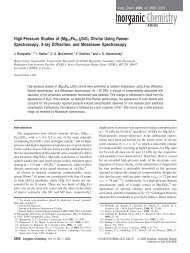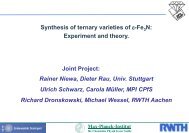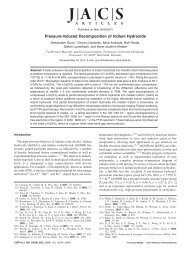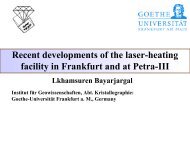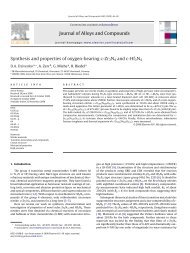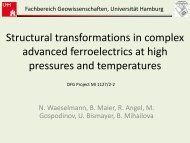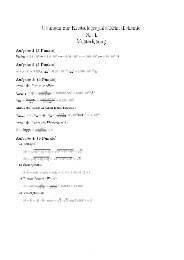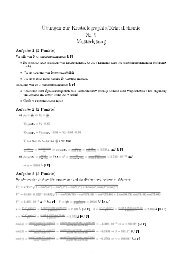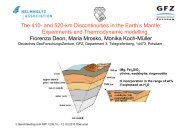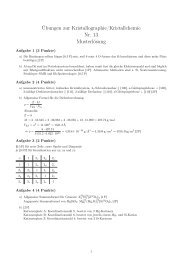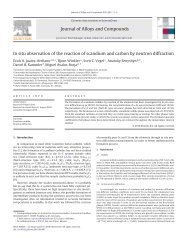Raman spectroscopic study of PbCO3 at high pressures and ...
Raman spectroscopic study of PbCO3 at high pressures and ...
Raman spectroscopic study of PbCO3 at high pressures and ...
You also want an ePaper? Increase the reach of your titles
YUMPU automatically turns print PDFs into web optimized ePapers that Google loves.
Phys Chem Minerals<br />
Fig. 10 <strong>Raman</strong> spectra <strong>of</strong><br />
internal vibr<strong>at</strong>ions as function <strong>of</strong><br />
pressure <strong>at</strong> 544(3) K: a v4-inplane<br />
b<strong>and</strong> (1 B 3g, 2 A 1g, 3 B 2g,<br />
4 B 1g); v 2; v 2 0 -out-<strong>of</strong>-plane<br />
b<strong>and</strong>s; 7, 8-two additional<br />
b<strong>and</strong>s; b v 1 <strong>and</strong> v 1 0 -symmetric<br />
stretching vibr<strong>at</strong>ions. The<br />
spectra were collected during<br />
decompression. Spectra are<br />
vertically <strong>of</strong>fset for clarity<br />
Intensity, a.u.<br />
(b)<br />
(a)<br />
4.85 GPa<br />
6<br />
8.11<br />
8.96<br />
10.15<br />
11.23<br />
12.24<br />
13.26<br />
13.89<br />
14.21<br />
14.78<br />
15.1<br />
16<br />
16.59<br />
17GPa<br />
640<br />
according to Liu et al. (2005). However, the aragonite used<br />
by these authors contained some significant amount <strong>of</strong> Sr 2?<br />
(2.5%), with ionic radius larger than th<strong>at</strong> <strong>of</strong> Ca 2? <strong>and</strong> can<br />
deterior<strong>at</strong>e the elastic moduli <strong>of</strong> aragonite. At the first<br />
transition (6–8 GPa) the general appearance <strong>of</strong> the spectrum<br />
<strong>of</strong> the internal modes does not change significantly,<br />
suggesting th<strong>at</strong> <strong>PbCO3</strong>-I <strong>and</strong> <strong>PbCO3</strong>-II could be pseudosymmetrically<br />
rel<strong>at</strong>ed, i.e. th<strong>at</strong> their space groups are<br />
probably in group-subgroup rel<strong>at</strong>ionship. The decreasing<br />
splitting <strong>of</strong> the v4 (B3g <strong>and</strong> A1g) b<strong>and</strong>s indic<strong>at</strong>es changes in<br />
the total geometry <strong>of</strong> the CO 3 2- groups, bringing them<br />
closer to trigonal symmetry. Phase-III starts to form <strong>at</strong><br />
about 10 GPa <strong>and</strong> has smaller dv/dP than phase-II, i.e.<br />
lower compressibility. As a result <strong>of</strong> our investig<strong>at</strong>ions a<br />
1<br />
680<br />
2v4<br />
3<br />
2 1 3<br />
7<br />
7<br />
720 760 800<br />
Wavenumber, cm -1<br />
v 2<br />
8<br />
8<br />
840<br />
880<br />
tent<strong>at</strong>ive model <strong>of</strong> the phase diagram can be constructed<br />
(Fig. 12). It contains three phases. Phase-I is cerussite with<br />
its aragonite-type structure, stable up to 8 GPa <strong>at</strong> ambient<br />
temper<strong>at</strong>ure. The presence <strong>of</strong> a new <strong>high</strong>-pressure phase<br />
PbCO 3-II could be confirmed. This phase forms reversibly<br />
<strong>and</strong> exists as a pure polymorph only in a small pressure<br />
range, from 8 to about 10 GPa <strong>at</strong> room temper<strong>at</strong>ure. The<br />
phase-I ? phase-II transition is accompanied by the disappearance<br />
<strong>of</strong> the B1g (v4) mode <strong>and</strong> a mode s<strong>of</strong>tening <strong>of</strong><br />
the v2 out-<strong>of</strong>-plane bending, which can be explained by<br />
increasing strength <strong>of</strong> the Pb–O bond with pressure. The<br />
neg<strong>at</strong>ive shift in pressure <strong>of</strong> the v2 b<strong>and</strong> is typical for<br />
aragonite-type carbon<strong>at</strong>es (Kraft et al. 1991). The <strong>high</strong>er<br />
frequency shifts <strong>of</strong> the phase-II modes indic<strong>at</strong>e th<strong>at</strong> the<br />
v 2 '<br />
6 GPa<br />
8.11 GPa<br />
8.96 GPa<br />
10.15 GPa<br />
11.23 GPa<br />
12.24 GPa<br />
13.26 GPa<br />
13.89 GPa<br />
14.21 GPa<br />
14.78 GPa<br />
15.1 GPa<br />
16 GPa<br />
16.59 GPa<br />
17 GPa<br />
123



